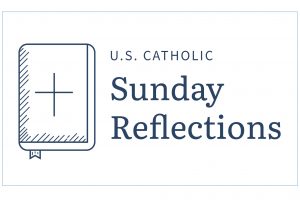I started working for U.S. Catholic on the day our office closed during the first wave of the novel coronavirus pandemic in March 2020. While I was bummed not to meet my new coworkers face to face, I embraced the chance to avoid a somewhat lengthy public transit commute in exchange for a workday spent at my dining room table. After all, this arrangement would allow me to use my time much more efficiently.
Working from home meant I could switch over laundry between meetings, prep dinner during my lunch break, and even collect and put away groceries from a doorstep drop-off service while waiting for a video to upload—not to mention the additional one or two “usable” hours added to my day by not having to ride the train. The foot commute from my bed to my computer screen takes approximately one minute, even less if I don’t have to stop to soothe a crying baby along the way (a common occurrence in my home-work environment).
Although a pandemic loomed outside our doors, this “work life”/“family life” optimization must be a version of the good life, I thought. Nearly a year and a half later, I’m less sure that efficient and optimized are the primary adjectives we should use to describe how we spend our time.
As I started to mentally and logistically prepare for the inevitable return to office work, I found myself disgruntled about the time I would soon “waste” commuting to and fro or “spend idle” in the workplace, unable to squeeze in washing another load of towels in the afternoon or chopping potatoes for dinner.
“You might actually like the downtime of a commute,” my husband offered. And as I rolled my eyes at the thought of embracing downtime as a full-time working mother of two young children, it occurred to me that the most significant lesson the pandemic had taught me is, in fact, the value—and the beauty—of doing nothing. While doing nothing doesn’t lessen the amount of work there is to do, it provides a welcome shift in perspective. It is OK if every minute of the day is not packed with productivity.
Unable to schedule outings or gatherings over the past 18 months, I truly came to treasure doing nothing with the other members of my household. Some days it felt like this time’s only purpose was to carry us forward to moments marked with something. Other days it felt like this downtime was exactly the something that my soul needed.
I’d like to remember this as I transition back into a lifestyle that will be busier in a lot of ways but that will also be punctuated with many more periods of inefficiency as we exist in places that are not our homes where we have instant access to every task and chore.
I’m less sure that efficient and optimized are the primary adjectives we should use to describe how we spend our time.
Advertisement
A lack of structured activity—or productivity—can in fact lead to feelings of fulfillment. When not filling time with tasks, we’re more apt to fill it with wonder. Riding on the train or highway with even the internet mostly out of reach offers time to simply think, imagine, or pray. This time spent in between is valuable. It brings greater value to our days by reminding us that our goal in life has never been to live most efficiently—but to live most lovingly in connection with the world and in relationship with those with whom we share it.
So while it’s going to take some rearranging of schedules to again find a routine that facilitates kids dressed, laundry washed, dishes done, dinner made, and professional responsibilities completed, perhaps there is a benefit to be found in the forced downtime of inefficient schedules that include times to relocate or rest. As the post-pandemic world speeds back up and our lives become increasingly busy, I’ll embrace a mindset that prioritizes peace over productivity and enjoyment over efficiency.
Peace and joy sound a lot more like the good life to me.
This article also appears in the July 2021 issue of U.S. Catholic (Vol. 86, No. 7, page 7). Click here to subscribe to the magazine.
Image: iStock











Add comment